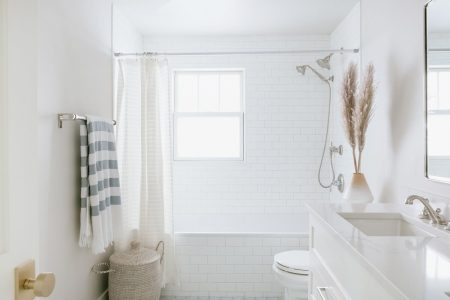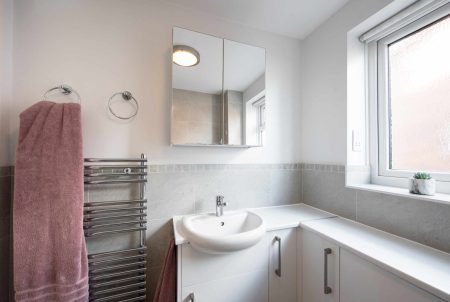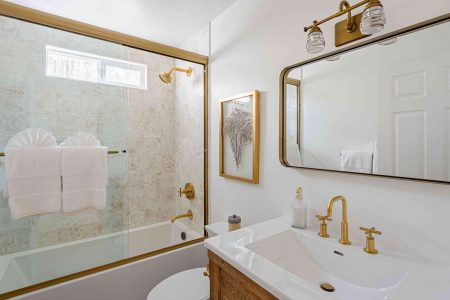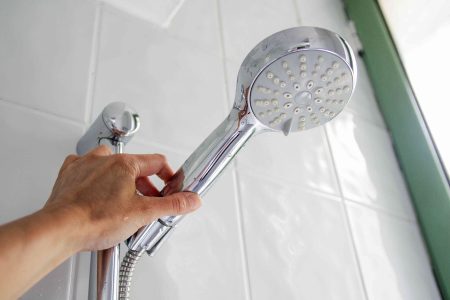Often the hardest part about installing plumbing in a bathroom is the rough-in stage. By way of contrast, the last step of connecting the sink, toilet, or tub can sometimes feel superfluous. If you get the rough-in right, you are most of the way toward project completion.
Roughing in bathroom plumbing is far less daunting when you understand how the system works. There are generally accepted plumbing rough-in measurements for sinks, toilets, and bathtubs or showers. In addition, fixture manufacturers typically provide rough-in specifications in their product literature. So, no guesswork or improvisation is needed. Simply follow the rough-in specs for perfect bathroom plumbing.
Understanding Rough-In Dimension Terminology
When speaking of plumbing dimensions, it’s important to understand the terminology. It’s not just a matter of semantics; it’s a matter of standardization and simplification. Centerline, for example, standardizes measurements and makes it easy to understand the distance between pipes without additional complicating factors like pipe width and pipe schedule or thickness.
Centerline: As with the term on-center, which is used for construction, the term “centerline” is an imaginary vertical line drawn through a key reference point, such as a drainpipe.
For an example of centerline: if two pipes are specified to be 10 inches apart centerline, you start the measuring tape or straightedge at the center of one pipe, then you measure 10 inches over to the center of the next pipe. You do not measure 10 inches between the edges of the pipes.
Base floor height: The base floor is considered to be the subfloor in new construction or the top of the finish floor (or floor covering) for bathroom remodel work.
Not all dimensions are set in stone; consider these dimensions to be general guidelines. They will vary according to your bathroom. Consult the instructions that come with the fixture (sink, tub, etc.) for more precise dimensions.
Supply line/discharge or drain: With bathroom plumbing, pipes either bring water in or take water out. Pipes that deliver fresh water to the bathroom are called supply lines or supply pipes. The braided flexible line that leads into the toilet to fill the tank is an example of a supply line. So are the hot and cold lines under the sink or behind the wall of the shower. Yet the thicker pipe under the sink that removes gray water is a drain line or discharge line.
| Toilet | Sink | Shower/Tub | |
| Supply Line (Vertical) | 8 1/4″ | 2″ to 3″ higher than drain pipe | 80″ shower; 20 to 22″ tub; spout 4″ above tub rim |
| Supply Line (Horizontal) | 6″ max from center | 4″ to left and right of center | 8″ apart |
| Discharge/Drain Hole from Back Wall | 12 1/2″ | N/A | 14″ |
| Discharge/Drain Hole (Vertical) | 0″ | 16″ to 20″ | 0″ |
| Fixture (Side to Side Buffer) | 15″ to 18″ min | 15″ to 20″ min | 18″ min |
| Fixture (Front Buffer) | 21″ min | 21″ min | 18″ min |
Toilet Rough-In Plumbing Dimensions
- Toilet supply line (height): Ideally, the toilet’s water supply line enters the room at 8 1/4 inches above the floor. More broadly, this cold-water-only pipe creates one hole between 5 and 10 inches above the floor.
- Toilet supply line (horizontal): Horizontally, the water supply line is measured from the centerline running vertically through the center of the toilet. The water supply line hole should be 6 inches to the side of the centerline. Check the toilet to confirm the location water supply connection.
- Toilet discharge hole from back wall: Offset hole from the back wall by 12 1/2 inches.
- Toilet discharge hole (vertical): Drain located at floor height; distance is zero.
- Toilet side-to-side buffer: Measured from the center of the toilet to either side, minimum. clearance is 15 inches to any wall or other fixture; 18 inches is recommended if the bathroom layout allows for this.
- Toilet front buffer: Measured from the front rim of the toilet forward, minimum clearance is 21 inches to the nearest obstruction; 30 inches recommended.
Bathroom Sink Rough-In Plumbing Dimensions
- Sink supply line (height): Two holes; vertically, both are about 2 to 3 inches above the drain pipe.
- Sink supply lines (horizontal): Two holes are required, one for the hot water supply and the other for the cold water supply. One hole is 4 inches to the right of the centerline and the other is 4 inches to the left of the centerline.
- Sink discharge hole (vertical): About 16 to 20 inches above the floor; consider the drain pipe to be the vertical centerline.
- Sink side-to-side buffer: From the centerline, 15 inches minimum, 20 inches recommended.
- Sink front buffer: Minimum distance to the nearest obstruction is 21 inches; 30 inches is recommended.
- Placement of sink: Vertically, the sink should be about 31 inches above the floor, measured from the top of the base floor to the rim of the sink.
Shower and Bathtub Bathroom Rough-In Dimensions
- Shower supply (vertical): 80 inches from the floor is where the shower arm will be located. The showerhead will be about 65 to 78 inches above the floor.
- Tub supply (vertical): Faucet valves should be 20 to 22 inches above the floor. Horizontally, each faucet goes 4 inches to the right/left of the centerline and the tub spout 4 inches above the tub rim.
- Discharge hole from back wall: Place drain on the centerline. The opening for drain access can be between 10 and 14 inches offset from framing, and 6 to 8 inches wide.
- Discharge hole (vertical): Drain located at floor height; distance is zero.
- Fixture (side to side buffer): 18 inches minimum required buffer.
- Fixture (front buffer): 18 inches minimum required buffer.
Read the full article here














